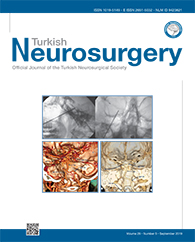2Istanbul Medeniyet University, Medical Faculty, Department of Radiology, Istanbul, Turkey
3Istanbul University, Cerrahpasa Medical Faculty, Department of Pathology, Istanbul, Turkey
4Istanbul GaziosmanpaÅa Taksim Research and Training Hospital, Neurosurgery Clinic, Istanbul, Turkey
5Istanbul University, Cerrahpasa Medical Faculty, Department of Neurosurgery, Istanbul, Turkey DOI : 10.5137/1019-5149.JTN.23078-18.2 AIM: To determine whether neuroradiological assessment of skull base and non-skull base meningioma consistency and vascularity can be used to improve the surgical approach.
MATERIAL and METHODS: Forty meningioma cases were split into skull base (n=16) and non-skull (n=24) base groups, and intraoperative surgical reports of observed tumor consistency (stiffness) and vascularity were compared with preoperative neuroradiological magnetic resonance (MR) perfusion and postoperative histopathological analysis of collagen and CD34 levels.
RESULTS: The skull base group had significantly higher CD34 levels (p=0.004) than the non-skull base group. Further comparison of CD34 levels also revealed significantly higher CD34 levels (p=0.032) in transitional versus fibroblastic subtypes. Observationbased vascularity scoring did not reveal a significant correlation between tumor grade and relative cerebral blood volume (p=0.604). In contrast, there was a statistically modest, but significant correlation between intraoperative observation-based consistency and Verhoeff-van Gieson collagen scores (rs=0.400).
CONCLUSION: Preoperative assessment of consistency and vascularity using MR imaging was ambiguous. Overall, one of the most important limiting factors was the subjective observational assessment of tumor consistency and vascularity by surgical teams.
Keywords : Meningioma, Magnetic resonance perfusion, Magnetic resonance imaging, Tumor stiffness, Tumor vascularity




